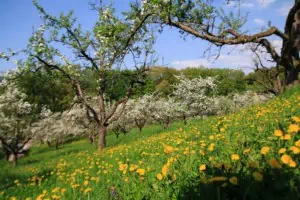Golf and biodiversity: What is a stepping stone biotope?
When it comes to the topic of golf & biodiversity, the term stepping stone biotope comes up again and again. But what exactly is meant by this?
Increase in species migration
Habitats are being altered by climate change. This results in many animal and plant species having to migrate to new areas. This involves overcoming barriers and distances that prevent access to resources and new habitats. If the obstacles cannot be overcome, populations become isolated and the risk of extinction increases. Scientists expect species migration to increase significantly in the coming years. Stepping stone biotopes are areas that serve to connect isolated habitats. From a nature conservation perspective, it is essential to ensure the highest possible structural diversity in a landscape area.
Stone piles as stepping stone biotopes
One building block and an effective way of doing this is the creation of reading stone piles, which are also counted as stepping stone biotopes. These provide homes for heat-loving species such as fence lizards, slow worms, spiders, beetles and wild bees. Reading stone piles allow a good ideal microclimate for many species. They are frost-free and dry hiding place in the winter.
But where and how should such a habitat be created on a golf course? The best place is where it does not disturb anyone, but still where interested golfers can have a closer look at the interesting pile of stones.
Stone piles belong to stepping stone biotopes, which otherwise come in a wide variety of forms. Stepping stone biotopes include, for example, hedges, rows of trees, embankments, copses, individual trees, flowering meadows or small bodies of water. They have one thing in common – they are natural “islands” for wildlife. The “inhabitants” find here dead wood, natural stones or even small watering places that help them to keep healthy, hide, warm, breed or even hibernate. An ideal case, then, for promoting biodiversity on a golf course. Golf courses can provide a biotope network by means of stepping stone biotopes.
Stepping stone biotopes are refuges between biotopes. They serve to preserve species and represent important elements within a biotope network to provide shelter for migratory animal species. The type and size of stepping stones will depend on the species they are intended to serve. With these regular or irregularly created areas, the survival of a species, but also the dispersal over larger distances, is made possible. They are the starting point or intermediate station for linking otherwise isolated habitats.
In addition, stepping stone biotopes should enable species to colonize new, suitable habitats as climate change progresses. Suitable places such as a wild corner, standing and lying dead wood, a dry wall – the possibilities for maintaining biodiversity are manifold. Flowering meadows or inconspicuous areas where nettles thrive can also serve as stepping stone biotopes.
The entire golf course as a stepping stone biotope
Speaking of serving – plants, animals, microorganisms and humans are the beneficiaries. Through golf, therefore, active nature conservation can be practised. Golf courses provide ecological benefits, and they can themselves be stepping stone biotopes buffer between the adjacent landscape and protected areas.
Nature reserves are not sufficient to ensure the survival of native flora and fauna. Space must also be provided outside these protected areas for the demands of wild native species, for their dispersal, migration and reproduction. In this sense, golf courses themselves become stepping stone biotopes, as large portions of land serve as nature conservation areas. Golf courses ensure stable, permanent habitats for native species and provide opportunities for reintroduction processes. They have connecting functions for animal migrations, natural dispersal and recolonization processes, and genetic exchange.
By linking stepping stone biotopes located within a golf course area and connecting the golf course with biotopes located outside, interconnected biotope structures are created that create development opportunities for conservation.








